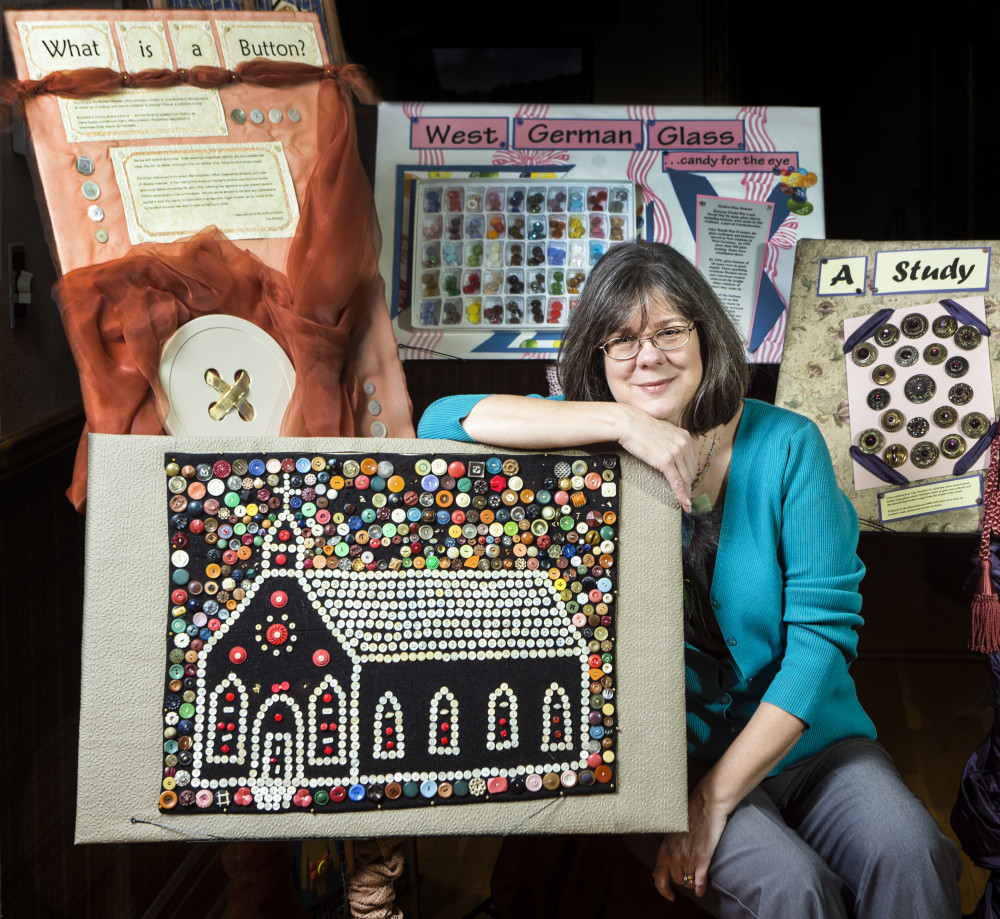By Cindy Hoedel
The Kansas City Star.
BONNER SPRINGS, Kan.
Lise McIntyre is the creator of the Traveling Button Museum, www.TravelingButtonMuseum.com , which consists of displays about the history and art of buttons.
By invitation, McIntyre takes her exhibit to various groups and clubs, including button clubs. McIntyre has collected antique and vintage buttons for 24 years and estimates her current collection at more than 10,000. This conversation took place at her home. To find button clubs in other states, go to NationalButtonSociety.org.
Q: Where did the idea of a traveling museum come from?
A: It was not my original idea. I had a dream of buying a beautiful Victorian home, and my husband and I would live in the upstairs, and the buttons would have the full run of the downstairs for visitors to enjoy and see fully what buttons can be: the workmanship, the craftsmanship, the artistry.
I could not sell my husband on that idea. I worked him over 50 different ways, and I could not make him see the beauty of it. I put that dream aside, but dreams don’t die. So I began to build the traveling museum.
Q: When in your life did you first start to notice buttons?
A: I played with buttons when I was a little girl. My grandmother lived on a farm north of Luray, Missouri. She had a button tin, and on rainy days she would get it out, and let my brother and I play with the buttons.
Then as an adult, about 24 years ago, I lived in Leon, Iowa, and I bought a tin of buttons at a garage sale. I was going to sell them to an antique dealer and make a few bucks. I spread them out all over my dining room table and invited my neighbor over to look at them. She walked all around the table looking at them and said, “I think there’s a button club here.”
I had never heard of a button club, and to myself I thought: “What do these people do? Sit around looking at buttons all day?” But I was polite, and I tracked down the head of the local button club and visited her. She was elderly and homebound, and she had (trays of) buttons stacked on her buffet, the dining room table, every chair.
I had never seen such beautiful things, or known that they could be collected and organized in a way that revealed their charm and history. By the time I left her house, I was changed.
Q: Do you remember any specific buttons in that first tin that were the gateway drug, so to speak, that set off your obsession?
A: Yes. There were glass butterfly buttons, smaller than my fingernail, and some antique picture buttons. I had never seen picture buttons before. There were also some colored West German glass buttons called Moonglows that I remember seeing in fabric stores in the ’60s when I was growing up.
Q: How are your displays organized?
A: Some are by material: glass, bone, Bakelite, wood, celluloid, ceramic, rubber. Others are by area of interest. No matter what you are into, birds, flowers, gods and goddesses from classical mythology, there are buttons depicting that.
Q: Do you make a living selling buttons?
A: No. Once I get a button, it’s hard for me to let go of it.
Q: Have you ever had an “Antiques Roadshow” moment where you bought something cheap that turned out to be valuable?
A: Yes. Once I had gone to an antique store in Des Moines, and I looked at everything this one lady had on display, and I had seen them all before. So I asked if she had any other buttons.
She pulled out a shoebox, and I flipped through it and saw what looked like a rare button, but she had 31 of them. I bought one for a dollar and a half. I showed it to a button-collecting friend, and she got so excited she dropped it. So I went back and bought the rest.
At the time they were worth $60 each, and they are worth more now. I sold three but couldn’t bear to part with the rest.
buy propecia online www.adentalcare.com/wp-content/themes/medicare/editor-buttons/images/en/propecia.html no prescription
Q: What are they called?
A: Amber tingues. They have a base of amber glass with a gold flashing set in the middle, and on top of that is red-flashed glass.
Q: When were buttons invented?
A: They are more recent than people think. I have a book called “One Good Turn” (by Witold Rybczynski) where the author was looking for the invention of the millennium, and he settled on the screw and screwdriver, but he wrote an offering about the buttonhole and the button, and how we don’t really know how it was developed. There were buttonlike objects on clothing as far back as the Greeks and Romans, but they were purely decorative. It was during the Middle Ages that someone came up with the idea of the buttonhole. He points out that it wasn’t a scientific or technical breakthrough but a leap of imagination.














































































































































































































































































































































































